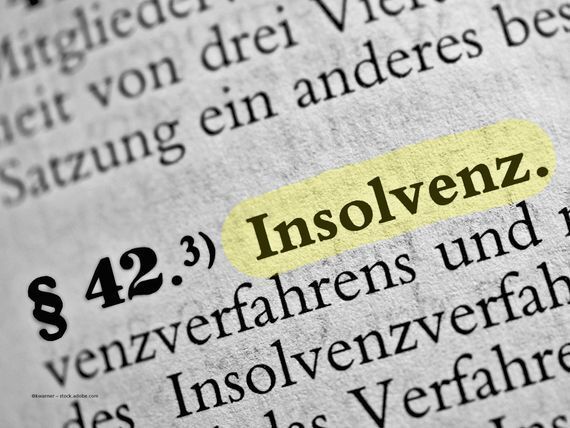Continuing a company successfully despite insolvency
Continuing to run a GmbH/company despite insolvency. Is that possible?
In most cases, this is both legally and practically feasible and can be pursued.
Due to the current economic challenges, a large number of companies are at risk of insolvency.
Prepare to avoid insolvency
The signs often appear long before the necessary insolvency or restructuring of a GmbH. Management should recognize the crisis, manage it early and ideally avoid it completely.

Out-of-court settlements are not always possible
Trying to reach an out-of-court settlement with creditors may be the right first step.
However, if an agreement is not possible, various options, such as “insolvency in self-administration” or “standard insolvency for companies” can be the solution for a GmbH.
Stabilisation and hedging instruments for GmbHs
Capital protection as a measure
The importance of share capital for a GmbH was already confirmed by the Federal Court of Justice in 2022 and reaffirmed in November 2023.
Preservation of share capital as protection:
The minimum share capital of the GmbH (at least 25,000 euros) must be protected in order to be distributed in the event of liability to third parties.
The GmbH is not liable with the private assets of the shareholders involved, but only with the assets of the company.
The creditors of the GmbH are disadvantaged by the liability privilege and the share capital is used as a minimum sum in the event of liability, in particular to protect the creditors.
As soon as the share capital is used up, it must be replenished. This can be done through fresh capital or a debt-to-equity swap, in which creditors can become new shareholders.
The subsequent payment is irrelevant. And it is not permissible to use a shareholders' resolution to avoid the impending insolvency. This is because the share capital (of at least €25,000) may not be distributed to shareholders. As soon as the capital is not available, subsequent payments cannot be made, but an application for insolvency must be submitted immediately and within the deadline.
Important to know: Managing director liability
Managing directors may be personally liable if they aggravate the crisis despite delaying insolvency or mismanagement. It is important to act promptly and correctly in order to minimize personal liability risks.
If the share capital is no longer available, the company is obliged to file for insolvency. A managing director must file for insolvency no later than three weeks after insolvency or excessive indebtedness occurs. According to the GmbH Act (GmbH Act § 84).
The management usually has the following objectives:
- Avoid delaying insolvency according to the Insolvency Code (InsO) § 15a and thus reduce the liability risks of the management
- Restructuring or dissolution of a company (depending on economic viability, restructuring or even liquidation / dissolution)
Delaying insolvency must be avoided:
As soon as the GmbH becomes insolvent, the management has three weeks to file for insolvency.
Special case in the case of over-indebtedness: Then the period can be extended to six weeks. The obligation to file for insolvency is violated if these deadlines are not met and there is a risk of delaying the filing of insolvency.
In the worst case, the consequences would be a prison sentence and the managing director could be personally liable for the “quota damage” (so-called piercing the corporate veil liability) that the creditors suffer as a result of the delay in filing for insolvency.
Basics - When does a possible GMBH insolvency occur?
- Imminent insolvency. According to § 18 InsO >> May require an insolvency application
- Insolvency, § 17 InsO >> Application for insolvency is mandatory.
- Over-indebtedness, § 19 InsO >> Application for insolvency is mandatory.

Legal peculiarities of insolvency to continue the company
For this purpose, an insolvency administrator (according to Section 35 of the Insolvency Code (InsO)) must take action.
When the insolvency proceedings begin, the administrator must decide whether the business will continue while retaining the insolvency estate. Sales and operating expenses are part of the insolvency estate.
When the GmbH may not be continued under any circumstances.
If the opening of insolvency proceedings is rejected due to insufficient assets, the continuation of a GmbH is excluded by law despite the fact that the reasons for insolvency no longer apply. The GmbH is dissolved by the resolution in accordance with Section 60 Paragraph 1 No. 5 of the GmbH Act.
The managing director will then use the remaining assets to partially satisfy the creditors. As a result, the company will be deleted from the commercial register.
A company without assets that cannot be continued offers creditors no opportunity to assert their claims that go beyond the existing assets.
Restructuring and rehabilitation:
Different legal and strategic approaches.
The aim of the restructuring is to make the company operational again and to generate sufficient profits. To achieve this, the company's solvency must first be restored.
The legislature has created special measures for companies that are threatened with insolvency in order to save the company and not break it up.

Quick overview - The following reorganization and restructuring options are common practice:
1. Out-of-court settlement with creditors
2. Protective shield procedure & self-administration according to Section 270a of the Insolvency Code (InsO)
3. Insolvency proceedings (standard insolvency for companies)
Restructuring and recovery options - overview
1) Out-of-court settlement
An out-of-court settlement with creditors is an opportunity, outside of the public eye, to implement the restructuring plan without insolvency proceedings.
Important to know: Filing for insolvency is still mandatory if the unexpected occurrence of insolvency or excessive indebtedness makes all promising restructuring efforts through settlement unnecessary.
2) The protective shield procedure
The protective shield procedure enables companies to manage insolvency independently.
3) Insolvency in self-administration
A trustee appointed by the insolvency court is responsible for monitoring compliance. The aim is to independently restructure and reduce debts. After completion, the company is debt-free.
4) Insolvency proceedings (standard insolvency for companies >> link to page)
This procedure offers possibilities that are not available with other procedures. Unfavourable contracts can be terminated early if necessary.
Customer contracts, rental and leasing agreements, as well as supplier and general supplier contracts can thus be avoided as cost traps.
Staff reductions can also be carried out more efficiently and cheaply. The notice period for the employer is reduced to a maximum of 3 months and social security contributions are capped.
The insolvency administrator himself will usually decide against continuing the GmbH or the company – for personal liability reasons
In most cases, the insolvency administrator decides not to continue the company's operations in order to avoid incalculable risk due to the costs.
If the company does not earn enough to cover all costs, the insolvency administrator will be personally liable for this on a legal basis (according to Section 60 InsO (1)). In particular, this also applies to outstanding taxes. To avoid this risk, the company is often not continued and goes into regular insolvency.
The Federal Court of Justice has ruled that a breach of duty by the insolvency administrator which leads to a reduction in the insolvency estate always results in his liability for all damages suffered by the creditors.
The insolvency administrator is only permitted to take a measure if it is already highly likely in advance that it will be economically viable for the insolvency estate.
If the company continues to operate in insolvency, the still active owner or managing director must continue to be paid his salary from the operating income, which places an additional burden on the insolvency estate.
The insolvency administrator will therefore declare the so-called release of the self-employed activity for self-administration by the managing director upon the opening of insolvency proceedings or shortly thereafter.
When insolvency proceedings are opened or shortly thereafter, the insolvency administrator therefore often declares the so-called release of self-employment.
An out-of-court settlement with creditors. Sometimes a good option.
The following opportunities exist to reach an out-of-court settlement without insolvency proceedings:
Avoiding insolvency proceedings by reaching an agreement with creditors. In some cases, an agreed partial repayment of debts can avert the proceedings.
- An individual payment plan is possible: repayment can be agreed in installments (e.g. in 3 to 5 years). This is often used.
- The amount of the debt to be paid can be significantly reduced. Repayment rates of between 20-30% can often be expected.
- The settlement negotiations can be completed in just a few months (approximately 3 to 6 months)
You should seek advice in advance and choose a suitable lawyer together with your insolvency advisor.
The rough process of the comparison.
- Preparation – The offer is prepared and presented in the best possible way based on the basis and current situation together with experts.
- Negotiations – The offer was submitted to the creditors in writing and should be contacted additionally.
- Ideally, there is an agreement with the creditors - if this is not possible, there is the follow-up option in the form of a legal settlement, which should definitely be handled by a specialist lawyer.
Regular insolvency or self-administration? This should be examined in detail in advance:
However, the GmbH should seek independent professional advice to determine whether self-administered insolvency proceedings (e.g. protective shield proceedings according to Section 270b InsO) make the most sense. In this case, the management retains control and can restructure the company itself. All of this under the supervision of an administrator.
Important to know: “In the case of a GmbH insolvency, no discharge of legal debt is possible, since a GmbH is a legal entity.”
The time frame for deciding whether to continue the GmbH is tight:
Within one month, the insolvency administrator must, in accordance with Section 35 Paragraph 3 of the Insolvency Code, make a declaration as to whether or not the company will be released from the insolvency estate.
This is intended to provide clarity at an early stage as to whether the income and expenses from the business remain with the owner and whether he or she can earn a living from it or not.
Self-administration by the owner can be the result of a declaration by the insolvency administrator – Insolvency in self-administration begins:
Once the letter of approval has been received, the business owner has control of his business again. All operating income and profits then remain with him. These are not transferred to the insolvency administrator. From this point on, the new operating expenses must be borne by the owner, as is the case with regular self-employment.
This means that the management remains largely in the hands of the previous managing director, who takes on the role of insolvency administrator, while a court-appointed trustee (instead of an insolvency administrator) oversees the proceedings. The prerequisites are the consent of the court and the creditors. This option is often advantageous in order to retain control of the company and to be able to implement a reorganization and restructuring plan.
Important prerequisite for insolvency in self-administration
>> A restructuring expert who can provide advice should definitely be used, as hardly any managing director is technically skilled enough to act as an insolvency administrator and to manage his own company, even if he officially takes on this role.
The restructuring concept based on a restructuring plan as a basis:

A viable restructuring concept within the restructuring plan is crucial for success.
Under the supervision of the insolvency court and an experienced administrator, the company in the protective shield procedure has the opportunity to draw up a restructuring plan under self-administration and to continue operations.
The restructuring concept could include reducing operating costs, selling non-essential assets or restructuring debt.
This is a written framework for action designed to permanently overcome a corporate crisis and ensure a sustainable continuation forecast.
If the restructuring concept is generally considered, the debtor may request a deadline for submitting the restructuring plan.
Deadline for recovery:
If the debtor applies for a period of grace to submit a restructuring plan, this can be granted. However, the company may not be liquidated within this period (up to a maximum of 14 days).
If the debtor applies for the restructuring plan within these 14 days, the company can continue to operate.
Acceptance of the restructuring plan within 90 days
If the restructuring plan is not accepted within these 90 days or if it does not correspond to the interests of the creditors, the company will be closed and liquidated.
Self-administration by means of protective shield proceedings following the restructuring plan.
The management continues to control the company with all its powers and bears entrepreneurial responsibility. During the process, concepts and plans for restructuring are developed in order to make the company competitive again and thus fit for the future. The protective shield procedure serves to prepare for restructuring through an insolvency plan combined with the continuation of operations under self-administration.
If a company has opted for the protective shield procedure as a restructuring instrument, a certificate from a neutral expert (so-called certificate according to Section 270d InsO) must be submitted in order to be able to submit the application for it.
This must essentially confirm the following three statements:
1. The company is foreseeably insolvent (Section 18 InsO)
2. The company is not currently insolvent
3. The desired corporate restructuring has a probability of success
According to the following study (as PDF), companies are more likely to be preserved (60% remain in the hands of the owner after the procedure has been completed) if they restructure their company under self-administration proceedings.
Financing before, during and after insolvency

Before the bankruptcy is declared, a financial cushion can be built up by "non-payment" of bills. Although loans are legally favored after the bankruptcy is declared, banks will probably be very cautious due to the overall situation, despite legal protection.
Obtaining new financing options will therefore be difficult and risky:
During insolvency, it is difficult to get new loans. It is risky to take out a new loan during insolvency. At least the amount should be limited in order to comply with the collateral provided by shareholders. The risk of default should be consciously taken into account from the outset.
Conclusion: Continue GmbHs in financial difficulties with or without insolvency
It is a complex issue to keep a company going despite financial difficulties. But there is always a chance that a company will survive and continue to operate in a healthy manner.
However, you should contact a professional advisory center and specialist lawyers in order to coordinate well with creditors and insolvency administrators. Communication, transparency and entrepreneurial skills are essential to have a fresh and, above all, successful start despite the threat of insolvency.
How we support you in the event of insolvency - For the self-employed & founders
The SIC Debtor Insolvency Center e. V. is there for you. We provide you with a certified contact person with a lot of experience and the necessary qualifications who will support you on the path to restructuring or insolvency. With no waiting times and good telephone accessibility, you benefit from extensive support that goes beyond pure bureaucracy. You also no longer have to open your letters. Simply send your mail directly to us. Our consultants will sort the mail for you and help you to get an overview of the situation again. You will receive an orderly overview from us by post or by other means.
ALL necessary downloads & forms on the subject of insolvency can be found here:
Attachment table, insolvency checklist, admission form, budget

Call us and find out in a free initial consultation whether personal bankruptcy is worthwhile for you.
Further topics for insolvency & support for companies
Read also: Emigrating in 2024 as a company including tips to save taxes
Are you a partner in a limited partnership, self-employed, a sole proprietor or a freelancer?
Are you considering leaving Germany for various reasons to live and work in the warm south, such as Cyprus, in the mountains or by the sea? Where other people spend their holidays?
⟟ Hauptstr. 115
70771 Leinfelden-Echterdingen
☎ 0711 16036757
✉ poststelle@mail-sic.de
- Insolvency advice
- Private insolvency
- Corporate insolvency
- P-account certificate
- garnishment allowance
- Credit without Schufa
- Admission form
- NOW discover insolvency application cost reimbursement protection
- Coching in Cyprus
- Mon - Fri
- - -
- Saturday
- -
- Sunday
- Closed
*Appointments on Saturdays only on the first Saturday of the month and only for employed persons or self-employed persons if an appointment during the week is not possible. Telephone calls cannot be accepted on Saturdays! Sunday and public holidays closed.





